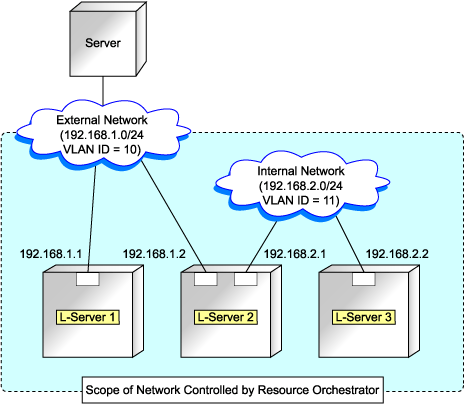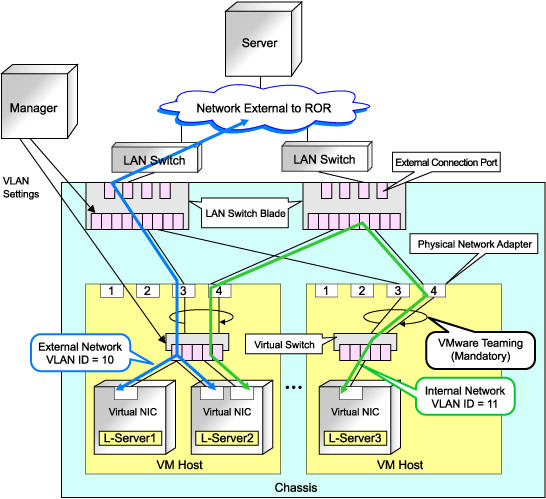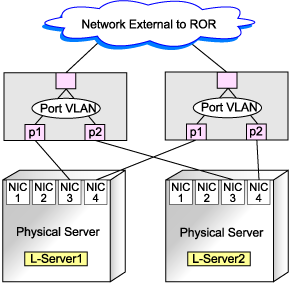Network resources handled by Resource Orchestrator consist of network definition information used for L-Server connection. Network configurations can be set in advance so that network settings are automated when creating an L-Server.
Network resources are categorized into the following two types:
Internal network
Used to connect an L-Server to another L-Server. The following information is retained:
VLAN ID for use on the connection path
IP address range (optional) to assign to the NIC for a connected L-Server
External network
Used to connect an L-Server to an existing network that is not managed by Resource Orchestrator. In addition to internal networks, the following information is retained:
Networks managed by Resource Orchestrator, and LAN switch blades for network connection and their ports (hereinafter external connection port)
Automatic VLAN Configuration for Blade Servers
By connecting the NIC for an L-Server to a network resource, the following settings are automatically configured for blade servers.
[Windows/Linux]
Port VLAN settings for the server blade port of LAN switch blades
[VMware]
Tagged VLAN and virtual switch settings for the server blade ports of LAN switch blades
[Hyper-V]
VLAN ID settings on the virtual network adapters of virtual machines
The automatic creation of virtual networks and automatic configuration of external networks (including the physical network switch) are not supported.
It is necessary to create the virtual network and configure the external network in advance.
For details on how to configure networks, refer to "4.2.5 Network Resources".
IP Address Range Auto-Configuration
[Windows/Linux][VMware]
If an IP address range is set for a network resource, the IP address can be automatically set when deploying an image to an L-Server. However, when a Red Hat Enterprise Linux image is specified when creating an L-Server with server type "Physical", the IP address will not be configured automatically.
Manually configure the IP address after the image has been deployed to the L-Server.
If no IP address range is set, the DHCP settings are adopted.
[Hyper-V]
Automatic configuration of IP addresses is not supported.
If an IP address range is set for a network resource, set an IP address manually after deploying an image to an L-Server (Also set an IP address manually on the DNS server). For details on how to confirm IP addresses, refer to the Note of "D.4 [Network] Tab".If an IP address range is not set, manually set an IP address for operation on the DHCP server after deploying an image to an L-Server.
Configuring VLANs automatically on LAN Switch Blades
switch mode
Automatic configuration of tagged VLANs and port VLANs are performed.
IBP mode
Automatic configuration of VLANs is not supported.
Network Resource Connection Image
The image of connection of network resources is as shown below:
Figure 1.2 Network Resource Connection Image

Note
For Hyper-V and rack mount server environments, it is necessary to configure the external connections of the external network manually.
LAN Switch Blade and Virtual Switch Configuration Example Using Network Resources [VMware]
The following is a configuration example of a LAN switch blade and virtual switch configuration using network resources.
Figure 1.3 LAN Switch Blade and Virtual Switch Configuration Using Network Resources [VMware]

Note
When network settings have been performed automatically for an L-Server in a VMware environment, redundancy of virtual switches and physical network adapters will be performed using VMware Teaming.
The LAN switch blade configuration can only be performed in switch mode.
LAN Switch Blade Configuration Example Using Network Resources [Windows/Linux]
The following is a configuration example of LAN switch blades using network resources.
Figure 1.4 LAN Switch Blade Configuration Example Using Network Resources

Virtual NIC Configuration and Connection with Virtual Networks Using Network Resources [Hyper-V]
An example of virtual NIC configuration with virtual networks using network resources is given below:
Figure 1.5 Virtual NIC Configuration and Connection with Virtual Networks Using Network Resources [Hyper-V]
